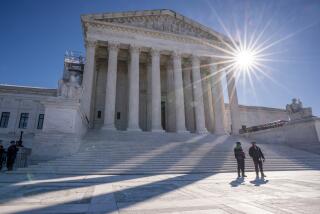Justices OK Media Use of Phone Tape
- Share via
WASHINGTON — The Supreme Court ruled Monday that the news media have a free-speech right to publish information of public concern from illegally intercepted phone calls or electronic transmissions.
The 6-3 ruling undercuts recent privacy protection laws that were designed for a new era of wireless phones and computer e-mails.
Those laws make it illegal to intercept or to “disclose . . . the contents of any wire, oral or electronic communication.”
But in some instances, the high court said, the 1st Amendment’s protection for “the publication of truthful information of public concern” overrides the right to privacy in personal communications.
The ruling protects not only the news media, but anyone who receives information from an intercepted communication--even if the person knows the information was obtained illegally. However, it remains illegal to intercept these private exchanges.
Its future effect may be greatest in the area of e-mails and the Internet. In 1986, Congress passed a law to protect users of cell phones whose conversations could be easily intercepted because of the technology in use at the time. However, newer digital cell phone technology makes it all but impossible to overhear and record such conversations.
Monday’s decision threw out a lawsuit brought against a radio broadcaster in northeastern Pennsylvania who aired a tape recording of a cell phone call between two officials of a local teachers union.
The union was involved in heated contract talks with the school board. If the board members resisted a raise for the teachers, one official told the other, “we’re going to have to go to their homes . . . to blow off their front porches.”
No one knows who recorded the call. It was put in the mailbox of a local anti-tax advocate, who in turn gave it to the radio broadcaster.
Gloria Bartnicki and Anthony Kane, the union officials, sued the radio broadcaster, Frederick Vopper, under the 1986 federal law.
Violators can be prosecuted and sent to prison, or as in this case, sued for damages.
If taken literally, the federal law would hold liable anyone who disclosed the contents of calls, even out-of-town newspapers that wrote about the controversy in the Wyoming Valley of Pennsylvania. Most states, including California, have similar privacy protection laws.
In the past, the Supreme Court has said the 1st Amendment generally shields the press to allow disclosure of accurate information about matters of public importance. Justice John Paul Stevens cited these precedents in Monday’s opinion. He relied on the Pentagon Papers case of 1971, in which the justices cleared the way for the New York Times to publish the government’s secret history of the Vietnam War.
“A stranger’s illegal conduct does not suffice to remove the 1st Amendment shield from speech about a matter of public concern,” Stevens said in Bartnicki vs. Vopper, 99-1687.
His opinion does not spell out what is meant by a matter of public concern. However, it does not include “trade secrets or domestic gossip or other information of purely private concern,” he said.
In a concurring opinion, Justices Stephen G. Breyer and Sandra Day O’Connor said they found the case to be a close call. They stressed they were not upholding a free-speech right to disclose gossipy details about a person’s private life. Monday’s decision “does not create a public interest exception that swallows up the [law’s] privacy protecting general rule. Rather, it finds constitutional protection for the publication of intercepted information of a special kind,” Breyer said.
However, Chief Justice William H. Rehnquist filed a forceful dissent, saying the decision exposes millions of Americans to having their private conversations revealed to the world. “The venerable right to privacy . . . must embrace a right to be free of surreptitious eavesdropping on, and involuntary broadcast of, our cellular telephone conversations,” he said. Justices Antonin Scalia and Clarence Thomas joined his dissent.
News media lawyers said they were pleased and somewhat surprised by the ruling. It has been a decade since the justices sided with the press in a major case.
“What is significant is that they said there is no exception to the press’ 1st Amendment rights when you are talking about truthful information and a matter of public concern,” said Washington lawyer Lee Levine, who represented the radio broadcaster.
However, Marc Rotenberg of the Electronic Privacy Information Center said users of cell phones and computers should be put on notice. “For the users of the communications technologies, the Supreme Court has put out a warning signal. It says you may be overheard, your conversation can be published, and you will have no remedy,” he said.
Monday’s ruling may well kill off a lawsuit growing out of an intercepted cell phone conversation involving former House Speaker Newt Gingrich.
In December 1996, John and Alice Martin overheard on a scanner Gingrich speaking with Rep. John A. Boehner (R-Ohio) about the ethics charges pending against Gingrich. The Martins recorded the call and gave the tape to Rep. Jim McDermott (D-Wash.), who in turn gave it to the New York Times, which published an account.
The Martins pleaded guilty to a criminal charge and paid a fine. In 1998, Boehner sued McDermott, and a U.S. Court of Appeals rejected the Democrat’s free-speech claim. But McDermott appealed to the high court, which has been holding the case, pending the outcome of the case decided Monday.
More to Read
Sign up for Essential California
The most important California stories and recommendations in your inbox every morning.
You may occasionally receive promotional content from the Los Angeles Times.














